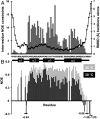Structure of the EF-hand domain of polycystin-2 suggests a mechanism for Ca2+-dependent regulation of polycystin-2 channel activity
- PMID: 20439752
- PMCID: PMC2889120
- DOI: 10.1073/pnas.0912295107
Structure of the EF-hand domain of polycystin-2 suggests a mechanism for Ca2+-dependent regulation of polycystin-2 channel activity
Abstract
The C-terminal cytoplasmic tail of polycystin-2 (PC2/TRPP2), a Ca(2+)-permeable channel, is frequently mutated or truncated in autosomal dominant polycystic kidney disease. We have previously shown that this tail consists of three functional regions: an EF-hand domain (PC2-EF, 720-797), a flexible linker (798-827), and an oligomeric coiled coil domain (828-895). We found that PC2-EF binds Ca(2+) at a single site and undergoes Ca(2+)-dependent conformational changes, suggesting it is an essential element of Ca(2+)-sensitive regulation of PC2 activity. Here we describe the NMR structure and dynamics of Ca(2+)-bound PC2-EF. Human PC2-EF contains a divergent non-Ca(2+)-binding helix-loop-helix (HLH) motif packed against a canonical Ca(2+)-binding EF-hand motif. This HLH motif may have evolved from a canonical EF-hand found in invertebrate PC2 homologs. Temperature-dependent steady-state NOE experiments and NMR R(1) and R(2) relaxation rates correlate with increased molecular motion in the EF-hand, possibly due to exchange between apo and Ca(2+)-bound states, consistent with a role for PC2-EF as a Ca(2+)-sensitive regulator. Structure-based sequence conservation analysis reveals a conserved hydrophobic surface in the same region, which may mediate Ca(2+)-dependent protein interactions. We propose that Ca(2+)-sensing by PC2-EF is responsible for the cooperative nature of PC2 channel activation and inhibition. Based on our results, we present a mechanism of regulation of the Ca(2+) dependence of PC2 channel activity by PC2-EF.
Conflict of interest statement
The authors declare no conflict of interest.
Figures







References
-
- Wu G, et al. Somatic inactivation of Pkd2 results in polycystic kidney disease. Cell. 1998;93(2):177–188. - PubMed
-
- Nauli SM, et al. Polycystins 1 and 2 mediate mechanosensation in the primary cilium of kidney cells. Nat Genet. 2003;33(2):129–137. - PubMed
-
- Koulen P, et al. Polycystin-2 is an intracellular calcium release channel. Nat Cell Biol. 2002;4(3):191–197. - PubMed
-
- Qian F, et al. PKD1 interacts with PKD2 through a probable coiled-coil domain. Nat Genet. 1997;16(2):179–183. - PubMed
Publication types
MeSH terms
Substances
Grants and funding
LinkOut - more resources
Full Text Sources
Other Literature Sources
Molecular Biology Databases
Miscellaneous

